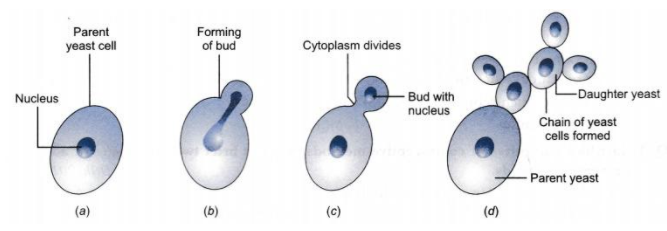How Does Budding Work in Hydra, Yeast, and Plants?
Budding is a form of budding asexual reproduction where a new organism develops from a small outgrowth, known as a bud, on the parent. In other words, it is an asexual process that produces a genetically identical replica of the parent. In budding reproduction, the new organism initially remains attached to the parent until it matures enough to separate, leaving behind a scar or remnant.
Budding definition: A method of reproduction in which a new organism grows from a certain part of the parent’s body.
Budding meaning: It implies that the offspring is not produced by the fusion of gametes but by cell division, making it a clone of the parent.
Types of Budding
Budding is seen in a variety of life forms. Let’s explore its different forms.
Budding in Hydra

Hydra, a small freshwater cnidarian, is one of the best examples when discussing budding in hydra. Here’s how budding works in these fascinating creatures:
A small bud emerges from the body of the parent hydra.
Through repeated cell division, the bud grows while still attached to the parent.
Once mature, the bud detaches, leaving a visible scar.
This process is a classic example of budding reproduction and demonstrates the regenerative capabilities of hydra. By studying budding in hydra, students can learn how simple organisms reproduce asexually with remarkable efficiency.
Budding in Yeast

Yeasts are another excellent model for understanding budding in yeast. These single-celled fungi reproduce using an asymmetric process:
A small outgrowth (or bud) forms on the parent yeast cell.
The nucleus of the parent cell divides, and one nucleus migrates into the bud.
Over time, the bud grows into a full-sized cell, which eventually separates from the parent.
Budding in yeast diagrams typically shows the sequential stages of bud formation, nuclear migration, and cell division. This process highlights the elegance of budding asexual reproduction in unicellular organisms and is crucial for understanding basic cell biology.
Budding in Plants
While less common than in hydra or yeast, budding in plants also occurs. In horticulture and plant propagation, bud grafting is a practical application where a bud from one plant is inserted into another. This technique is widely used to produce genetically identical plants, ensuring the desired traits are maintained.
The method of budding in plants is another form of asexual reproduction that benefits agriculture and plant breeding. It is a controlled process where the bud eventually develops into a new branch or individual plant.
Additional Insights on Budding
Beyond hydra, yeast, and plants, budding is employed by many other organisms. Here are some unique aspects that set this process apart:
Regeneration and Repair: Some organisms use budding not just for reproduction but also for repair. This regenerative ability is crucial in species that face environmental challenges.
Environmental Adaptability: Because budding does not involve genetic recombination, the offspring are clones. This can be advantageous in stable environments where the parent's traits are well-suited.
Evolutionary Perspective: While sexual reproduction promotes genetic diversity, budding asexual reproduction ensures rapid population increase under favourable conditions.
These unique points about budding help us appreciate its importance not only in biology but also in practical applications like medicine and agriculture.
Related Links:


FAQs on Budding in Biology: Understand Asexual Reproduction Easily
1. What is budding in biology?
Budding is a type of asexual reproduction where a new individual develops from a specific site on the parent's body, forming an outgrowth or 'bud'. This bud grows, develops the features of the parent, and eventually detaches to live as an independent organism.
2. What are some common examples of organisms that use budding?
Many simple organisms reproduce through budding. The most common examples studied in the NCERT syllabus are:
- Hydra: A small freshwater animal where a bud grows from the body wall.
- Yeast: A single-celled fungus where a small bud forms on the parent cell.
- Other examples include corals, sponges, and some flatworms.
3. Why is budding considered a form of asexual reproduction?
Budding is classified as asexual because it involves only one parent. The new organism that grows from the bud is genetically identical to the parent, essentially a clone. There is no mixing of genetic material from two different individuals, which is the defining characteristic of sexual reproduction.
4. How is the process of budding in Hydra different from budding in yeast?
The main difference is in their cellular organisation. Hydra is a multicellular animal, so budding involves the organised division of many cells to form a miniature, multicellular version of the parent. In contrast, yeast is a single-celled organism, and budding is a simpler process where a small protrusion forms on the parent cell, the nucleus divides, and one nucleus moves into the bud before it pinches off.
5. What is the key difference between budding and binary fission?
The key difference is how the parent divides. In budding, the division is unequal; a small bud forms on a large parent, and the parent organism remains after the bud detaches. In binary fission, the division is equal; the parent cell splits into two identical daughter cells, and the original parent effectively ceases to exist.
6. What are the main advantages of budding for an organism?
The main advantage of budding is its speed and efficiency. An organism can reproduce rapidly without needing to find a mate, which is very useful in stable environments with plenty of resources. This allows for a quick increase in population size. The process also requires less energy compared to sexual reproduction.
7. In budding, does the parent organism survive after the new individual detaches?
Yes, in true budding, the parent organism survives and continues to live its life after the bud separates. The bud is simply an outgrowth, and its detachment does not harm or end the life of the parent. This is a defining characteristic of the budding process.










